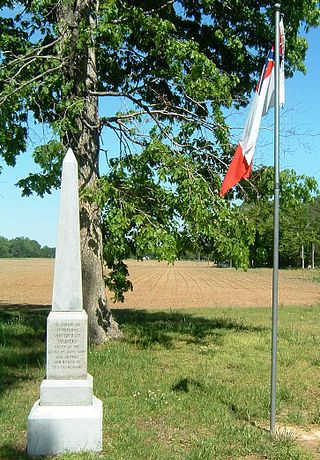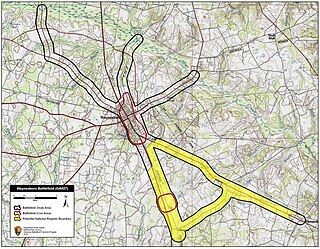
Philip Henry Sheridan was a career United States Army officer and a Union general in the American Civil War. His career was noted for his rapid rise to major general and his close association with General-in-chief Ulysses S. Grant, who transferred Sheridan from command of an infantry division in the Western Theater to lead the Cavalry Corps of the Army of the Potomac in the East. In 1864, he defeated Confederate forces under General Jubal Early in the Shenandoah Valley and his destruction of the economic infrastructure of the Valley, called "The Burning" by residents, was one of the first uses of scorched-earth tactics in the war. In 1865, his cavalry pursued Gen. Robert E. Lee and was instrumental in forcing his surrender at Appomattox Courthouse.

The First Battle of Winchester, fought on May 25, 1862, in and around Frederick County, Virginia, and Winchester, Virginia, was a major victory in Confederate Army Maj. Gen. Thomas J. "Stonewall" Jackson's Campaign through the Shenandoah Valley during the American Civil War. Jackson enveloped the right flank of the Union Army under Maj. Gen. Nathaniel P. Banks and pursued it as it fled across the Potomac River into Maryland. Jackson's success in achieving force concentration early in the fighting allowed him to secure a more decisive victory which had escaped him in previous battles of the campaign.

Sherman's March to the Sea was a military campaign of the American Civil War conducted through Georgia from November 15 until December 21, 1864, by William Tecumseh Sherman, major general of the Union Army. The campaign began on November 15 with Sherman's troops leaving Atlanta, recently taken by Union forces, and ended with the capture of the port of Savannah on December 21. His forces followed a "scorched earth" policy, destroying military targets as well as industry, infrastructure, and civilian property, disrupting the Confederacy's economy and transportation networks. The operation debilitated the Confederacy and helped lead to its eventual surrender. Sherman's decision to operate deep within enemy territory without supply lines was unusual for its time, and the campaign is regarded by some historians as an early example of modern warfare or total war.

James Harrison Wilson was a United States Army topographic engineer and a Union Army Major General in the American Civil War. He served as an aide to Maj. Gen. George B. McClellan during the Maryland Campaign before joining Maj. Gen. Ulysses S. Grant's army in the Western Theater, where he was promoted to brigadier general. In 1864, he transferred from engineering to the cavalry, where he displayed notable leadership in many engagements of the Overland Campaign, though his attempt to destroy Lee’s supply lines failed when he was routed by a much smaller force of Confederate irregulars.

The Atlanta campaign was a series of battles fought in the Western Theater of the American Civil War throughout northwest Georgia and the area around Atlanta during the summer of 1864. Union Maj. Gen. William Tecumseh Sherman invaded Georgia from the vicinity of Chattanooga, Tennessee, beginning in May 1864, opposed by the Confederate general Joseph E. Johnston.

The Battle of Williamsburg, also known as the Battle of Fort Magruder, took place on May 5, 1862, in York County, James City County, and Williamsburg, Virginia, as part of the Peninsula Campaign of the American Civil War. It was the first pitched battle of the Peninsula Campaign, in which nearly 41,000 Federals and 32,000 Confederates were engaged, fighting an inconclusive battle that ended with the Confederates continuing their withdrawal.
The Battle of Lovejoy's Station was fought on August 20, 1864, near what is now Lovejoy, Georgia, in Clayton County, during the Atlanta Campaign of the American Civil War. The two sides had arrived at something of a stalemate, with the Union army half-encircling Atlanta and the Confederate defenders staying behind their fortifications.

Hugh Judson Kilpatrick was an officer in the Union Army during the American Civil War, achieving the rank of brevet major general. He was later the United States Minister to Chile and an unsuccessful candidate for the U.S. House of Representatives.

The Battle of Haw's Shop or Enon Church was fought on May 28, 1864, in Hanover County, Virginia, as part of Union Lt. Gen. Ulysses S. Grant's Overland Campaign against Confederate Gen. Robert E. Lee's Army of Northern Virginia during the American Civil War.

The Battle of Old Church, also known as Matadequin Creek, was fought on May 30, 1864, as part of Union Lt. Gen. Ulysses S. Grant's Overland Campaign against Confederate Gen. Robert E. Lee's Army of Northern Virginia during the American Civil War.

The siege of Corinth was an American Civil War engagement lasting from April 29 to May 30, 1862, in Corinth, Mississippi. A collection of Union forces under the overall command of Major General Henry Halleck engaged in a month-long siege of the city, whose Confederate occupants were commanded by General P.G.T. Beauregard. The siege resulted in the capture of the town by Federal forces.

The Carolinas campaign, also known as the campaign of the Carolinas, was the final campaign conducted by the Union Army against the Confederate Army in the Western Theater of the American Civil War. On January 1, Union Maj. Gen. William T. Sherman advanced north from Savannah, Georgia, through the Carolinas, with the intention of linking up with Union forces in Virginia. The campaign culminated in the defeat of Confederate Gen. Joseph E. Johnston's army at the Battle of Bentonville, and its unconditional surrender to Union forces on April 26, 1865. Coming just two weeks after the defeat of Robert E. Lee's army at the Battle of Appomattox Court House, it signaled that the war was effectively over.
The Second Battle of Dalton was fought August 14–15, 1864, between Union and Confederate forces in Whitfield County northern Georgia.

The Battle of Waynesboro was an American Civil War battle fought on December 4, 1864 in eastern Georgia, towards the end of Sherman's March to the Sea. Union cavalry forces under Brig. Gen. Judson Kilpatrick defeated Confederate cavalry led by Maj. Gen. Joseph Wheeler, opening the way for William T. Sherman's armies to approach their objective, Savannah.
The Battle of Griswoldville was the first battle of Sherman's March to the Sea, fought November 22, 1864, during the American Civil War. A Union Army brigade under Brig. Gen. Charles C. Walcutt fought three brigades of Georgia militia under Brig. Gen. Pleasant J. Philips, at Griswoldville, near Macon, Georgia, and continued its march toward Savannah.

The Battle of Altamaha Bridge, also known as the Battle for the Doctortown Railroad Trestle, was an American Civil War engagement fought December 19, 1864, in Wayne County, Georgia, during Sherman's March to the Sea. The Confederate victory prevented Federal forces from destroying a vital railroad bridge during Maj. Gen. William T. Sherman's siege of Savannah, keeping open Confederate supply lines to the city.

The Knoxville campaign was a series of American Civil War battles and maneuvers in East Tennessee during the fall of 1863 designed to secure control of the city of Knoxville and with it the railroad that linked the Confederacy east and west, and position the First Corps under Longstreet for return to the Army of Northern Virginia. Union Army forces under Maj. Gen. Ambrose Burnside occupied Knoxville, Tennessee, and Confederate States Army forces under Lt. Gen. James Longstreet were detached from Gen. Braxton Bragg's Army of Tennessee at Chattanooga to prevent Burnside's reinforcement of the besieged Federal forces there. Ultimately, Longstreet's Siege of Knoxville ended when Union Maj. Gen. William Tecumseh Sherman led elements of the Army of the Tennessee and other troops to Burnside's relief after Union troops had broken the Confederate siege of Chattanooga. Although Longstreet was one of Gen. Robert E. Lee's best corps commanders in the East in the Army of Northern Virginia, he was unsuccessful in his attempt to penetrate the Knoxville defenses and take the city.

The Battle of Culpeper Court House was an American Civil War skirmish fought September 13, 1863, near Culpeper, Virginia, between the cavalry of the Union Army of the Potomac and that of the Confederate Army of Northern Virginia. The Union victory opened up the Culpeper region to Federal control, a prelude to the subsequent Bristoe Campaign.
The 5th Ohio Cavalry Regiment was a regiment of Union cavalry raised in seven counties in southwestern Ohio for service during the American Civil War. It primarily served in the Western Theater in several major campaigns of the Army of the Tennessee.

The Battle of Bentonville was fought in Johnston County, North Carolina, near the village of Bentonville, as part of the Western Theater of the American Civil War. It was the last battle between the armies of Union Maj. Gen. William T. Sherman and Confederate Gen. Joseph E. Johnston.

















